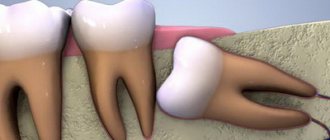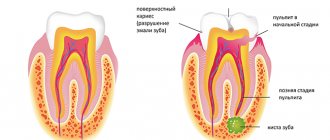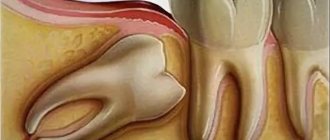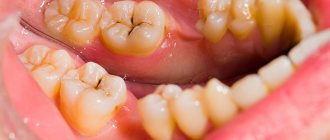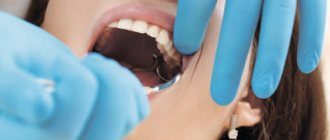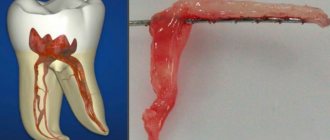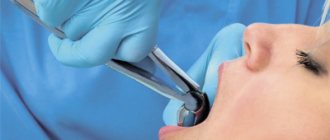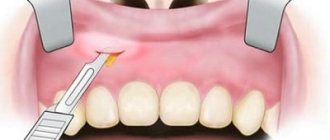From this article you will learn:
- the gums around the wisdom tooth are inflamed: what to do,
- wisdom tooth: hood and its removal (price for 2021),
- how to relieve inflammation.
The article was written by a dental surgeon with more than 19 years of experience.
Difficulty in the eruption of wisdom teeth is often accompanied by the development of inflammation of the gums around them. The mucous membrane of the gums, which partially covers the crown of the erupting wisdom tooth, is called the wisdom tooth hood (Fig. 1-3).
Because The hood over the wisdom tooth is not tightly adjacent to the crown of the tooth - a semi-closed space is formed between them, in which favorable conditions are created for the proliferation of pathogenic bacteria and the development of inflammation. In dentistry, an inflamed hood on a wisdom tooth is usually called “pericoronitis.”
General idea of pathology
During the eruption of a wisdom tooth, it is often covered by a mucous membrane of gum tissue, which is not completely sealed, but maintains a gap between itself and the growing molar. Dentists call this tissue formation a hood.
The main danger of forming a hood over an erupting molar is the possibility of tiny food particles penetrating underneath it, which are almost impossible to remove through normal hygiene procedures.
These food particles become a site for the development and reproduction of pathogenic microflora, upon interaction with which rotting processes begin, causing the development of infection .
At the same time, the gum tissue loses its density and begins to bleed under any mechanical stress.
In dental practice, such inflammation of the gum mucosa is called pericoronitis .
The pathology requires immediate professional treatment , as over time it can lead to more serious consequences for the oral cavity.
When a wisdom tooth is removed along with the hood
There are several reasons why only partial removal is ineffective. Among them, the first place in a kind of popularity ranking goes to insufficient free space.
In practice, this means that a massive tooth simply has nowhere to grow without cutting through the still healthy surrounding surfaces of varying degrees of hardness. If it has a problematic growth slope towards a neighboring tooth or even bone, then it is subject to emergency excision. After this, healing will not take long to occur.
In second place is the absence of other teeth adjacent to the third molar. Then preserving the problematic “tenant” does not have any practical benefit, because such a long distance is not suitable for reliable prosthetics.
Adding to the complexity is the fact that the formation of a hood is the prerogative of exclusively those wisdom teeth that have not yet been able to fully stick out. Because of this, a complex operation may take longer, and the recovery period may be longer than usual.
The reason for the delay is that there is simply no special scheme for accessing the problematic tooth from its socket using standard dental instruments. Here everything depends on the individual characteristics of each victim, which prompts the doctor to use a drill to divide the tooth into several parts. Only after this will it be possible to remove the cut parts from the alveolar process.
For such a long-term intervention, the dentist may use general anesthesia if he sees that his patient is on the verge of having a panic attack. The dentist will come to the same logical conclusion when he is faced with the irresistible gag reflex of his patient. This is explained by the fact that even the most careful master sometimes touches the patient’s tongue, which in some people provokes a strong vomiting reaction. To avoid traumatic situations, it is more productive to simply put a person into a stage of artificial sleep.
Contraindications for general anesthesia are only pregnancy in the first and last trimester.
The price of the service will depend entirely on what type of anesthesia was used, and whether anything else had to be removed other than the actual hood.
Complications and symptoms
The first time after the formation of a hood over the erupting wisdom tooth, the person does not experience any unpleasant sensations. However, after food particles penetrate the mucous membrane, the process of decomposition and rotting begins, leading to the following symptoms:
- the appearance of an unpleasant putrid odor from the mouth;
- soreness of the soft tissue in the area of the growing tooth;
- swelling of the gums.
In the absence of therapeutic measures at this stage, the inflammatory process develops very quickly.
A person experiences the following signs of the development of an inflammatory process:
- increased swelling of the gums, its redness, which can spread to the surrounding areas of soft tissue and the cheek;
- discharge of purulent contents from the hood upon pressure or spontaneously;
- increased pain, especially when eating or other jaw movements;
- limited mobility of the lower jaw.
In addition to specific signs of the inflammatory process, a person experiences general weakness, headache, and increased body temperature . When palpating the submandibular lymph nodes, severe pain occurs.
Learn more about inflammation of the gums above the wisdom tooth and the symptoms of the pathology from the video.
Can it be confused with something else?
People inexperienced in dental matters sometimes mistake this problem for some other problem. For example, this happened to one patient whose one “seven” was “dead” because he had pulpitis before. The man began to form pus in his mouth, and he thought that the source was a “dead” tooth due to poor-quality filling.
But later it turned out that the filling was carried out competently and with good materials. And the pus came just from under the soft tissues above the “eight”, to which the “dead” “seven” was located close.
According to the reviews of many who encountered the problem, they did not immediately understand what was the matter. That is why, in order not to get confused, you should not make a diagnosis yourself. The doctor will handle this. If a regular dentist does not find anything critical, you should consult a surgeon.
Indications for gum excision
When pericoronitis passes from the initial stage to an advanced form, the only method of getting rid of the pathology is surgical intervention.
Experts insist on the need for surgical treatment of pathology in the following cases:
- the presence of purulent exudate in the space between the erupting molar and the soft tissue , which leads to its periodic release and the formation of a persistent putrid odor from the oral cavity;
- persistent pain during communication, chewing and swallowing food;
- the development of gingivitis - an acute inflammatory process occurring in soft tissue, as a result of which a person experiences constant pain radiating to the ear and temples;
- spread of swelling to the buccal area , which leads to the impossibility of fully opening the oral cavity;
- increased body temperature and its retention at a high level , soreness and swelling of the lymph nodes.
The presence of one or more of the listed conditions indicates the need to take prompt surgical measures to eliminate inflammation, since its further development is fraught with serious consequences.
Reasons for performing flap surgery on the gums and contraindications to the procedure.
Read here about the reasons for the appearance of exostosis after tooth extraction and methods for eliminating the problem.
At this address https://zubovv.ru/hirurgiya/rezektsiya/tsistotomii-ozhidaemyiy-rezultat.html all the most important things about performing a dental cystotomy.
What is a dental hood?
In recent years, researchers have increasingly recorded cases in which people’s wisdom teeth, called the third molar, do not grow at all throughout their lives. It is believed that in two centuries they will become completely rare.
By themselves, these parts of the oral cavity do not pose any threat if their growth is stable and normal. But such a successful scenario occurs extremely rarely. Usually a person additionally suffers from severe pain, increased body temperature, and general malaise.
Often the clinical picture is complemented by the fact that a hood begins to hang over the problematic structure, posing a serious threat to the well-being of the victim.
Content:
- What is a dental hood?
- Stages of inflammation
- How is the operation performed?
- When a wisdom tooth is removed along with the hood
- Practical recommendations
Since most wisdom teeth are pierced around the age of 18 to 25 years, gum growths with excess skin make themselves felt around this age and a little older. The fact that there are four such teeth in the body increases the risk factors. They are located on each side of both jaws.
Another difficulty is that at the moment of the “birth” of the third molar, the jaw system almost always has time to fully form. This means that there is no longer room for a new resident, which provokes tooth overlapping, displacement, displacement, incorrect growth in the wrong direction, squeezing and covering with part of the gum.
Just the latter case is referred to in professional medical terminology as an impacted tooth. This is the name given to a molar whose growth is blocked by soft or hard tissue. Some ordinary people believe that if there is not enough space in the oral cavity for a new “neighbor”, then it simply stops growing. But in fact, this is not a reason to stop, but only a reason for the “sufferer” to start looking for ways around it. Because of this, it prys off and then completely grows into the surrounding space of the gum or even bone structure, which brings not only a feeling of discomfort, but also unbearable pain.
Tolerating such a condition is strictly prohibited, especially since it is extremely difficult to stun the pain with standard painkillers in this situation. If the problematic tooth grows unevenly and at the same time manages not to touch the surrounding area too much, then although this reduces the risks of complications, it also provokes the development of that same hood.
The principle of its appearance is simple: first, the first half of the tooth erupts, cutting the gum. This forms a “roof” over the second part. Such soft tissue under the molar often becomes inflamed, bleeds, hurts, and can even secrete pus if the victim delays going to the dentist’s office.
Preparation
Despite the fact that excision of the hood is a fairly simple operation, careful preparation is required for its successful implementation.
It consists of performing the following procedures:
- Visual examination of the patient’s oral cavity and identification of complaints. At the initial appointment, the dentist finds out the characteristics and duration of the inflammatory process in the patient.
This will help to establish the cause of the development of pericoronitis and draw up an optimal treatment plan. - Instrumental examination of the oral cavity. The specialist refers the patient to X-ray and tomography.
These research methods make it possible to determine the direction of growth of the third molar, the number and location of its roots, and determine the condition of the jaw bone tissue. Based on the data obtained, the specialist determines whether it is possible to preserve the wisdom tooth or whether extraction will be required. - Determination of a person's health status. Before the operation, the patient must undergo a general blood and urine test to identify the presence of hepatitis, HIV infection, and syphilis.
An important stage in preparing for surgery is determining the level of blood clotting and identifying the reaction to anesthetic drugs that can be used during surgery. - Preparatory therapeutic measures. Often, the operation to excise the hood is preceded by measures aimed at relieving the acute inflammatory process.
Often it is necessary to remove mineralized deposits and eliminate carious lesions of adjacent molars. This allows you to reduce the risk of developing postoperative complications and speed up the further rehabilitation process.
The final date for the operation is set only after all of the above points have been completed and the person is fully ready to perform it.
Course of action
The operation to remove the hood over a wisdom tooth is performed as follows:
- Introduction of anesthesia. Based on the collected medical history, the dentist administers the selected painkiller to the patient. The procedure is often performed under local anesthesia, but if there are individual contraindications, it can be performed without it.
- Excision of gum tissue. After identifying the area of gum that overhangs the growing molar, using surgical scissors or a scalpel, the dentist excises the soft tissue. The purpose of this procedure is to completely expose the erupting tooth.
- Treatment of the wound surface. The excised soft tissue is treated with antiseptic drugs, cleaned of food residues, purulent contents and blood.
- Applying iodoform turunda or a compress with a healing preparation. This minimizes the risk of infection penetrating the treated surface and also promotes better healing of the gum tissue.
Upon completion of the procedure, the dentist sets a date for the patient’s next examination and prescribes medications that will need to be taken throughout the entire rehabilitation period.
Recovery period
The duration of healing of gum tissue depends on many factors - the anatomical features of the human body, the correctness of the operation, as well as the accuracy of the patient’s compliance with the recommendations of the attending physician.
To shorten the rehabilitation period, you should adhere to the following rules:
- do not eat for the first 2-3 hours after surgery;
- remove iodoform turunda when the specialist says, but no later than the next day after the operation;
- try not to chew food on the side of the jaw that was operated on;
- ensure that the food consumed is at a comfortable temperature for the oral cavity;
- During hygiene procedures, try not to touch the treated area of the gum with a toothbrush.
An important component of a quick and trouble-free rehabilitation period is taking all medications prescribed by the dentist.
As a rule, after removing the hood over an erupting molar, the specialist prescribes the following medications to the patient:
- painkillers , for example, Ketanov, Ibuprofen;
- anti-inflammatory drugs;
- antiseptic solutions - Miramistin, Chlorhexidine or disinfectant gels.
What to expect after the procedure
The use of a laser significantly shortens the recovery period. If with traditional intervention healing takes 7-10 days, then rehabilitation after laser excision of the hood is half as long. For several days after surgery, it is necessary to exclude spicy, coarse and sticky foods from the diet, as well as too hot and cold foods and drinks.
Excision of the hood with a laser for pericoronitis is not only the most effective tactic of surgical intervention, but also the least uncomfortable treatment method for the patient.
The need for figure eight extraction
It is not always possible to get rid of the inflammatory process only by removing the hood that has formed over the third molar. There are situations when a specialist insists on the need for wisdom tooth extraction.
This procedure is necessary in the following cases:
- lack of space in the jaw line for proper molar eruption;
- a large inclination of the wisdom tooth to the buccal side or to the area of the adjacent molar, which will entail regular injury to the mucous membrane or the root system of other elements of the row;
- absence of molars adjacent to the wisdom tooth - according to dentists, in this situation there is no point in preserving the element, since its participation in the chewing process is minimal.
Why is it worth eliminating the hood faster?
If you do not turn to a professional in time, the process sometimes reaches the point where a person’s jaw goes numb, and he is no longer able to open his mouth wide enough to excise soft tissue. All that remains is to go to the hospital.
The pus sometimes does not come out, but goes into the jaw, causing more serious inflammatory processes.
Therefore, until the “eights” finally sprout, they must be regularly monitored so as not to miss the moment when such intervention is necessary and still possible.
Price
The cost of removing a hood over an erupting wisdom tooth in clinics in the capital can range from 1,500 to 3,000 rubles.
Often this amount includes the initial examination, instrumental examination, anesthesia and the operation itself.
In some clinics, these accompanying procedures will have to be paid separately, so it is advisable for the patient to familiarize themselves with the price list in advance.
If the removal of the hood is accompanied by extraction of a wisdom tooth, the operation will cost 3000-5500 rubles.
What is the basis for performing plastic surgery of the anastomosis with the maxillary sinus?
This material is devoted to the surgical method of lengthening teeth.
Go here https://zubovv.ru/hirurgiya/rezektsiya/periostotomiya-operatsiya.html to find out what problems can be solved with the help of periostotomy in dentistry.
Therapy at home
Dentists are unanimous in the opinion that it is impossible to completely eliminate the inflammatory process developing in the hood above the eighth molar at home.
The use of folk remedies can temporarily eliminate symptoms and relieve pain, but over time the disease will progress, leading to more severe consequences.
If it is not possible to get to a specialist in a timely manner, alleviate the condition using the following actions:
- rinsing the mouth with a saline-soda solution every 2-3 hours;
- the use of rinsing solutions based on medicinal plants - chamomile, oak bark, calendula and sage flowers;
- application of Cholisal gel to inflamed gums.
It is worth understanding that the listed measures that can reduce pain can be used for no more than 2-3 days in a row. A longer absence of professional help can lead to the development of complications.
Problems in case of refusal of treatment
The lack of timely provision of dental care for inflammation of the gum tissue over the erupting wisdom tooth eventually leads to the transition of the acute stage of pericoronitis to the chronic stage. This is dangerous due to the spread of the infectious process to adjacent tissues and areas of the jaw row.
In the absence of treatment for a long time, the patient is diagnosed with a deterioration in the condition of bone tissue, the occurrence of phlegmon or abscess, and the development of osteomyelitis.
The purulent contents of the hood can spread throughout the oral cavity, leading to inflammation of the lymph nodes.
Pathogenic microflora that develops in the affected areas of the gum tissue penetrates the circulatory system, spreading throughout the body and causing various disturbances in its functioning.
If wisdom teeth erupt incorrectly, these complications may include the following pathologies:
- change in bite;
- damage to the root system of adjacent molars;
- injury to the buccal mucosa;
- destruction of bone tissue.
To avoid these consequences, dentists recommend seeking professional help when the first signs of discomfort associated with the eruption of a wisdom tooth occur.
From the video, find out the opinion of a specialist about the advisability of performing the procedure of excision of the gums above the wisdom tooth.
Physiotherapeutic treatment
Physiotherapy methods are also used to speed up the healing process:
- UHF therapy - one of the indications for the procedure is the presence of an inflammatory (including purulent) process in the tissues before and after opening the pathological focus. Ultrahigh-frequency therapy has anti-inflammatory, analgesic and resolving effects. The average course of treatment is 5 sessions.
- Microwave therapy is used to treat socket pain and complications of pericoronitis (periostitis and osteomyelitis). Course – 5-7 procedures.
- Irradiation of tissues with low-intensity laser radiation - laser radiation of this type has a local immunomodulatory and analgesic effect, relieves inflammation, and accelerates wound healing. Minimum course – 5 sessions.
Reviews
Removing the hood over a wisdom tooth is a fairly simple and common procedure performed in all major dental centers.
It is performed under local anesthesia and does not cause difficulties during the rehabilitation period.
At the same time, the procedure helps prevent further development and spread of the inflammatory process throughout the tissues of the oral cavity.
Share your experience in the matter of removing a hood over a wisdom tooth and the peculiarities of the rehabilitation period in the comments to the article.
If you find an error, please select a piece of text and press Ctrl+Enter.
Tags wisdom tooth removal wisdom tooth hood surgery
Did you like the article? stay tuned
Diagnostics
Any dentist can perform the diagnosis. To do this, you should study the symptoms and take an x-ray. Using the image, the doctor will see how the tooth is located, the condition of the bone tissue that surrounds it, as well as the condition of the periodontium. If the disease is chronic, then bone resorption is studied. Pericoronitis is treated by dentists in our dental center.
